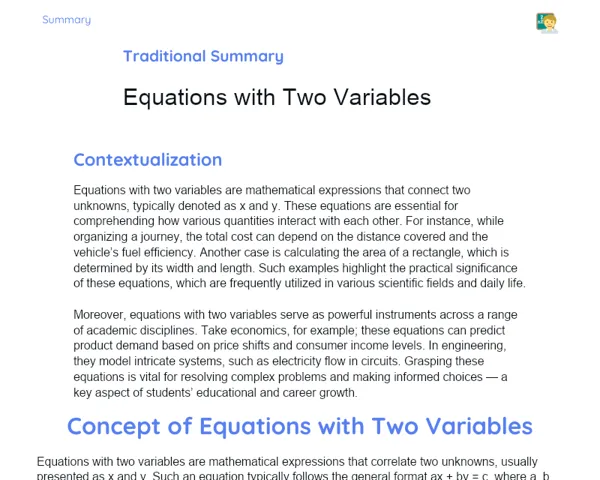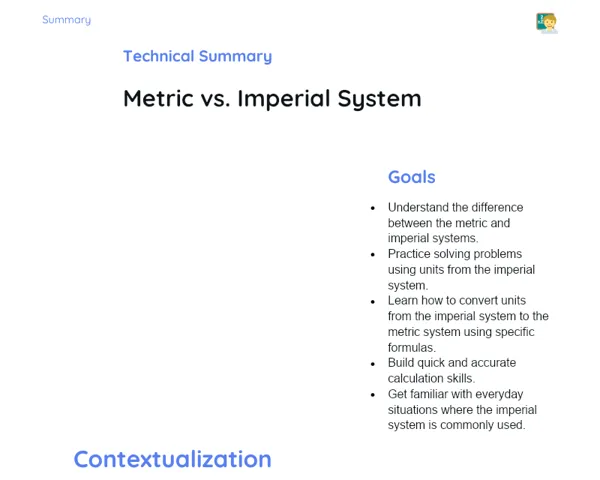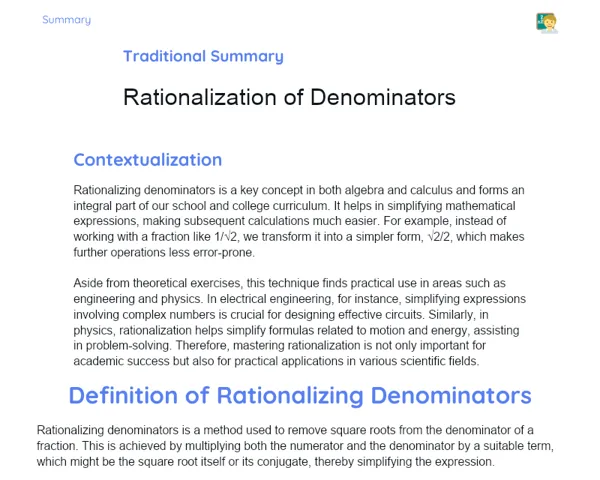Objectives
1. 🎯 Grasp the concept of the domain of a function, recognizing it as the set of values that the independent variable can attain.
2. 🎯 Identify and calculate the maximum domain of specific functions, like the square root function, which only accepts non-negative inputs.
Contextualization
Did you know that the domain of a function is not merely an abstract mathematical idea? It plays a vital role in fields such as engineering and physics! For instance, when we model the motion of a freely falling object, the domain of the time function is restricted to non-negative real numbers. Negative time does not make sense in our reality. This highlights that understanding the domain is about more than just numbers and equations; it’s about applying mathematics effectively in real-life scenarios.
Important Topics
Domain of Basic Functions
The domain of a function is the set of all input values where the function is defined. For example, the function f(x) = x² has a domain of all real numbers because x² is defined for any x. However, the function f(x) = 1/x is undefined for x = 0, so its domain is all real numbers except zero.
-
Identifying the domain avoids issues like dividing by zero or taking the square root of negative numbers, which are mathematically invalid.
-
Understanding the restrictions imposed by functions like square roots and logarithms is crucial, as these are undefined for negative arguments or zero.
-
The domain of a function can vary depending on the context, which is critical for mathematical modeling in various disciplines.
Domain of Composite Functions
In the composition of functions, the domain of the resultant function is the set of all input values that produce defined outputs from the composition. For instance, if f(x) = √x and g(x) = x + 4, then the composite function (f ∘ g)(x) = f(g(x)) = √(x + 4) is valid only for x ≥ -4, as f is undefined for negative inputs.
-
Understanding the domains of composite functions is crucial for tackling practical problems that require variable changes or sequential applications.
-
Exploring the domains of composite functions involves examining the individual functions and their interrelationships, enhancing students' logical reasoning and analytical skills.
-
Manipulating the domains of composite functions illustrates fundamental applications of algebra and calculus, highlighting how the concept of domain connects different areas of mathematics.
Domain of Inverse Functions
The domain of an inverse function consists of all output values from the original function that can serve as valid inputs for the inverse. For example, if f(x) = 2x and g(x) = x/2, then both functions are inverses with their domains being all real numbers. However, for f(x) = x² for x ≥ 0, its inverse g(x) = √x has the domain x ≥ 0.
-
Determining the domain of inverse functions is vital to ensure the inverse functions are valid and maintain bijection, meaning every input correlates to a unique output, and vice versa.
-
Studying inverse functions and their domains provides practical insights into how domain aspects influence inverses.
-
This topic equips students with the ability to address more complex problems where a comprehensive understanding of domains and function inverses is pivotal.
Key Terms
-
Domain: The set of all input values for which a function is defined.
-
Function: A relationship between a set of inputs (domain) and a set of outputs (codomain) that assigns exactly one output to each input.
-
Inverse Function: A function that reverses the operation of another function, swapping its inputs and outputs.
-
Function Composition: A mathematical process that involves applying one function to a value, followed by another function to the result.
For Reflection
-
How might our understanding of function domains impact mathematical modeling in real-world cases, like in engineering or the natural sciences?
-
Why is it essential to take domain restrictions into account when analyzing composite or inverse functions? Illustrate your perspective with examples.
-
In what ways could grasping the domain of functions aid in identifying typical mistakes in mathematical calculations or solving equations?
Important Conclusions
-
Today, we journeyed through the fascinating realm of function domains, a core concept that extends beyond mathematics into practical applications in fields like engineering, physics, and economics.
-
We discovered that the domain of a function encompasses all values the independent variable can assume while keeping the function valid, thus avoiding operations like division by zero and square roots of negative numbers.
-
We discussed real-life examples that show how understanding the domain is crucial for resolving actual problems and how this knowledge influences mathematical modeling, allowing for better decision-making.
To Exercise Knowledge
- Select a mathematical function and determine its domain, exploring any specific contexts that may confine the domain. 2. Plot the graph of the function f(x) = 1/(x-2) and visually identify its domain. 3. Formulate a small problem that applies the concept of domain in a real-life context, such as a driver’s reaction time while driving.
Challenge
Domain Detective Challenge: Receive a list of functions and attempt to deduce their domains without direct computation. Leverage properties of the domain to make educated guesses regarding the function's shape and behavior for different input values.
Study Tips
-
Review the concepts of domain and its properties using various resources, such as educational videos, interactive games, and real-world examples found in textbooks or online.
-
Practice identifying the domains of a diverse range of functions to sharpen your intuition and quick recognition of patterns.
-
Discuss with peers or teachers how the domain of a function can affect viable solutions and the implications of domain restrictions in different circumstances.



